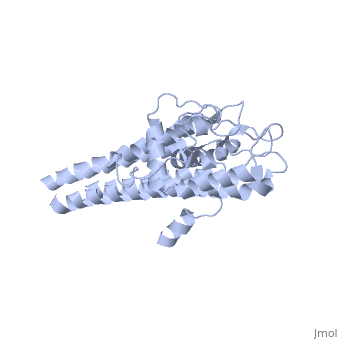VlsE of Borrelia
From Proteopedia
| Line 3: | Line 3: | ||
VlsE exists as a dimer molecule in its natural form, comprised of two identical molecules bonded together through weak ionic interactions. VlsE consists of one central variable domain in which its crystal structure is comprised of six invariable regions (IR1 to IR6), shown in different shades of blue and six variable regions (VR1 to VR6), shown in red. These variable domains are highly immunogenic; they stimulate an immune response in the body and they serves as a major target of the host immune response (Liang & Phillip, 1999). Most of the membrane-distal surface, which covers the α-helix, is made up of coiled forms of the VRs. The placement of these segments on the surface protects the hidden regions from coming into contact with antibodies and therefore serves as the immune evasion from antibody binding. The structure of VlsE indicates that the surface of the protein consists mainly of the variable regions, which goes through rapid sequence changes at a high rate during the early stages of an infection. Hence, the variable regions on the surface cover the invariable regions of the protein (Liang & Philipp, 1999). The exposed variable regions attract the antibodies and turn the immune system away from the invariable regions, leading to an evasion of the immune system. | VlsE exists as a dimer molecule in its natural form, comprised of two identical molecules bonded together through weak ionic interactions. VlsE consists of one central variable domain in which its crystal structure is comprised of six invariable regions (IR1 to IR6), shown in different shades of blue and six variable regions (VR1 to VR6), shown in red. These variable domains are highly immunogenic; they stimulate an immune response in the body and they serves as a major target of the host immune response (Liang & Phillip, 1999). Most of the membrane-distal surface, which covers the α-helix, is made up of coiled forms of the VRs. The placement of these segments on the surface protects the hidden regions from coming into contact with antibodies and therefore serves as the immune evasion from antibody binding. The structure of VlsE indicates that the surface of the protein consists mainly of the variable regions, which goes through rapid sequence changes at a high rate during the early stages of an infection. Hence, the variable regions on the surface cover the invariable regions of the protein (Liang & Philipp, 1999). The exposed variable regions attract the antibodies and turn the immune system away from the invariable regions, leading to an evasion of the immune system. | ||
| - | hi my name is kd | ||
---- | ---- | ||
<Structure load='1L8W' size='500' frame='true' align='right' caption='Insert caption here' scene='Insert optional scene name here' /> | <Structure load='1L8W' size='500' frame='true' align='right' caption='Insert caption here' scene='Insert optional scene name here' /> | ||
Revision as of 01:47, 7 May 2013
Lyme disease is a multistage, tick-borne infection that is prevalent in the United States, Europe, and Asia. The contributing bacterium that is related to this disease is the spirochete, Borrelia burgdorferi. VlsE is the lipoprotein of the Borrelia burgdorferi bacteria, which undergoes antigenic variation and plays a major role in the immune response to Lyme disease. A lipoprotein is a structure that contains both proteins and lipids, which allows the protein to integrate with the plasma membrane as a surface protein. It has an effective strategy developed by pathogenic microorganisms to evade the host immune system. The immune system normally reacts to antigens by producing particular antibodies to target that specific antigen. Memory B-cells will retain the proper antigenic counter for the foreign body. However, a variable antigen will frequently change the binding site, so the body will have to constantly look for a new antibody to target. Lyme disease can cause chronic neurologic, cardiovascular, and arthralgic manifestations lasting from months to years. Its persistence is due to the variable properties of the antigen, therefore it is important to understand the structure of VlsE to better counter this disease.
VlsE exists as a dimer molecule in its natural form, comprised of two identical molecules bonded together through weak ionic interactions. VlsE consists of one central variable domain in which its crystal structure is comprised of six invariable regions (IR1 to IR6), shown in different shades of blue and six variable regions (VR1 to VR6), shown in red. These variable domains are highly immunogenic; they stimulate an immune response in the body and they serves as a major target of the host immune response (Liang & Phillip, 1999). Most of the membrane-distal surface, which covers the α-helix, is made up of coiled forms of the VRs. The placement of these segments on the surface protects the hidden regions from coming into contact with antibodies and therefore serves as the immune evasion from antibody binding. The structure of VlsE indicates that the surface of the protein consists mainly of the variable regions, which goes through rapid sequence changes at a high rate during the early stages of an infection. Hence, the variable regions on the surface cover the invariable regions of the protein (Liang & Philipp, 1999). The exposed variable regions attract the antibodies and turn the immune system away from the invariable regions, leading to an evasion of the immune system.
|
Proteopedia Page Contributors and Editors (what is this?)
William Ji, Priya Madan, Maayan Vizana, Garshaw Amidi-Abraham, Alexander Berchansky, Michal Harel

